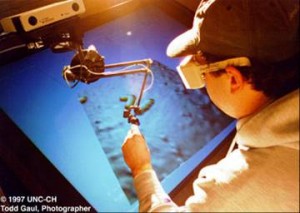nanoManipulator
How do you examine an unfamiliar object? You look at it. When possible, you pick it up, hold it at arm’s length, and turn it around. You may squeeze or prod to determine its stiffness; a fingernail feels for grooves or surface texture. If the object is on a surface, you may use a fingertip or pen to roll it around.How do you examine an unfamiliar object? You look at it. When possible, you pick it up, hold it at arm’s length, and turn it around. You may squeeze or prod to determine its stiffness; a fingernail feels for grooves or surface texture. If the object is on a surface, you may use a fingertip or pen to roll it around.

The nanoManipulator (nM) system provides a scientist with the ability to perform these actions on objects as small as single molecules while quantitatively measuring both the surface shape and forces applied. The nM uses the ultra-sharp tip of an atomic-force microscope (AFM) as tool both to scan and to modify samples. It uses advanced computer graphics to display the scanned surface to the user. A robot arm enables the user to feel and modify the surface (Taylor II 1993; Finch 1995; Taylor II 1997; Grant 1998; Taylor II 2003). — pic right of this paragraph!
The nM is the longest running of the current Resource projects, and is in the most advanced state of development. We continue to improve the system so that it remains useful in new experimental settings. The nM system currently has over 100 hierarchically grouped functions, each asked for by a user to address a particular challenge in an experiment. It has been ported from its initial configuration using a custom-built haptic display device, a custom-built SPM controller, and a custom-built graphics supercomputer to a configuration running entirely on commercially available equipment (PC-based graphics, the Phantom haptic display and Asylum SPMs).
nanoManipulator released as open-source in January 2014
The nanoManipulator was sold and supported by 3rdTech through the end of 2013. It was released in January 2014 under the Boost open-source license, with installers available on the software download page, along with an External Operations (XOP) module to connect it to an Asylum scanned-probe microscope. Contact support@nanomanipulator.org for the source code.